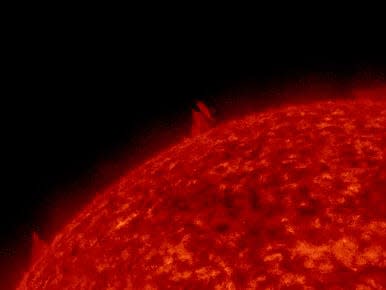A huge tornado on the sun released a cloud of hot gas 6 times the size of the Earth
A tornado on the sun released a cloud of hot gas about six times the size of the Earth into space.
The cloud was released alongside a powerful coronal mass ejection.
The sun has been fizzing with activity as it nears its most restless state in more than a decade.
NASA captured an enormous tornado on the sun's surface that released a cloud of hot charged gas about six times the size of the Earth.
The gas cloud was spotted by NASA's Solar Dynamics Observatory on Thursday.
It was accompanied by a powerful coronal mass ejection, an explosion that sends charged particles barreling through space, per space weather website spaceweather.com.

The cloud of gas was not launched toward Earth, so isn't dangerous for humans. Still, it is a symptom of the sun's current state of restlessness, which is increasing as it nears a peak of activity.
Every twelve years or so, the sun's poles flip. This causes our star to fizz with more solar explosions, sunspots, flares, and storms than when it is quiet. Eventually, the sun reaches a peak of activity and starts settling down again.
Scientists predict this peak should happen within the next year or so. In the meantime, they are keeping a close eye.
Solar weather is mostly harmless for humans, but a peak of solar activity increases the risk of a very rare, once-in-a-lifetime solar storm so powerful it could short power grids and knock out communication systems.
Solar observation systems are currently poorly equipped to predict such a storm, which could be felt on Earth very quickly.
The increased solar activity could also put deep-space astronauts at more risk being exposed to radiation, a major hindrance at a time when space agencies aim to send astronauts to the moon. NASA, for instance, wants to launch its Artemis 2 mission to fly astronauts around the moon in 2024.
The term "solar tornado" is only a nickname for the structure spotted on the sun, which is still poorly understood, experts previously told Business Insider.
"What we're seeing here is polar crown filament (PCF). A filament is a huge, twisted magnetic stricture that sits above the sun's surface, sometimes for months," Mathew Owens, a professor of space physics at the University of Reading, told BI in an email in March.
Plasma can be released when these magnetic fields come under too much tension and eventually break apart, Owens told BI.
The term "tornado" suggests the structure spins, but this might be a misnomer, Sven Wedemeyer, a professor of solar physics from the University of Oslo who has studied this phenomenon, told BI in March.
"You basically have two possibilities. Either you have some structure that's held together by magnetic fields that's actually truly rotating, or what you're seeing is plasma — hot gas — that's following some pre-twisted magnetic field and gives the appearance to be rotating, but is just moving up and down like a slight spiral," said Wedemeyer.
"One theory is if there's true rotation in there, this may trigger or destabilize the whole structure, which may contribute to this eruption," said Wedemeyer.
Read the original article on Business Insider
